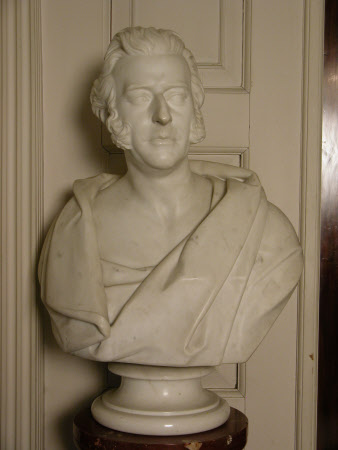Portrait bust of James Meadows Rendel, FRS (1799-1856)
Edward William Wyon (1811 - 1885)
Category
Art / Sculpture
Date
1856
Materials
Marble
Measurements
800 x 530 x 300 mm (31 1/2 x 22 x 12 in)
Place of origin
London
Order this imageCollection
Hatchlands Park, Surrey
NT 1166742
Summary
Sculpture, marble; p.Portrait bust of James Meadows Rendel, FRS (1799-1856); Edward William Wyon (1811-1885); 1856. A portrait bust, signed and dated 1856, depicting the civil engineer James Rendel, friend and business partner of the engineer and industrialist Sir William Armstrong (1810-1900), and father of Stuart Rendel (Lord Rendel of Hatchlands, 1834- 1913), who bought Hatchlands in 1888.
Full description
A marble portrait bust of the engineer James Meadows Rendel (1799-1856), showing the subject wrapped in a loose toga-like garment, looking to his left. Mounted on a turned marble socle. Signed and dated 1856 on the back. James Meadows Rendel was a leading civil engineer who became a close friend and business partner of the engineer Sir William Armstrong. Born in Devon, he worked as a young man for Thomas Telford, before beginning his professional career in Plymouth, with the building of a bridge across the river Plym. He subsequently built or assisted with the design of several suspension bridges across Britain, whilst also becoming an acknowledged authority in hydraulic engineering, improving and developing harbours across the south-west. After moving to London in 1838, Rendel became involved in dock, harbour and railway projects across Britain, and as far afield as South Africa and India. In 1843, James Rendel met Armstrong when he visited Newcastle to carry out a survey of the river Tyne. Rendel believed passionately in the potential of hydraulic water power and persuaded Armstrong, then still working as a lawyer, to overcome his father’s initial objections and to begin manufacturing hydraulic machinery. The two men collaborated on a major scheme for the improvement of the docks at Grimsby, which featured hydraulically powered lock gates, sluices, and cranes and a 300 feet high hydraulic tower. They became close friends, the childless Armstrong all but adopting Rendel’s third son George Wightwick Rendel (1833-1902), who also became an engineer and naval architect. His other sons Alexander Meadows Rendel (1829-1918) and Stuart Rendel, 1st Baron Rendel (1834-1913) also worked with and for Armstrong. Edward William Wyon was a member of the Wyon dynasty of die-engravers and medallists, but unlike other members of his family he practised principally as a sculptor, exhibiting at the Royal Academy over many years. A number of his portraits were designed for production in Parian ware, including his portrait of James Meadows Rendel. A version in Parian ware, part of a series of commemorative portraits of engineers produced by Minton after portraits by Wyon, is at Sir William Armstrong’s former home Cragside (NT 1230988), and another example is in the Museum of the History of Science, Oxford (Inv. 11296). In this case, though, Wyon also made a full-size marble version of the portrait, probably made after Rendel’s death. The bust now at Hatchlands is likely to be the marble version exhibited at the Art Treasures exhibition in Manchester in 1857 (Manchester 1857, no. 138). A terracotta version from 1855 was formerly in the collection of the Institute of Civil Engineers, but is now lost. Jeremy Warren May 2023
Provenance
Bought in 1888 by Stuart Rendel; by descent to Harry Stuart Goodhart-Rendel (1887-1959); Christie’s London, 7 March 1958, where bought by the Ministry of Works; transferred by HM Treasury to the National Trust.
Marks and inscriptions
Back:: EDWARD W. WYON. SCULPTOR. 1856
Makers and roles
Edward William Wyon (1811 - 1885), sculptor
References
Catalogue of the art treasures of the United Kingdom, collected at Manchester. 1857., p. 136, no. 138. Roscoe 2009: I. Roscoe, E. Hardy and M. G. Sullivan, A Biographical Dictionary of Sculptors in Britain 1660-1851, New Haven and Yale 2009, p. 1431, no. 37.
